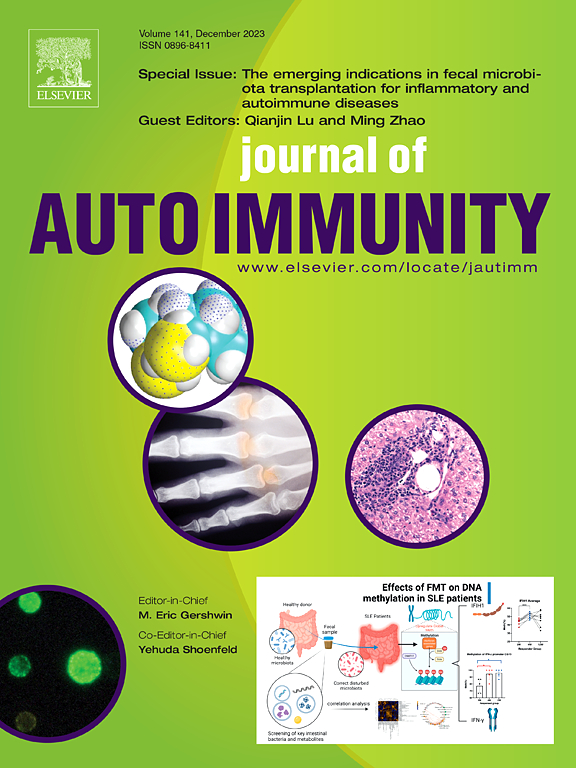肉样瘤病的免疫发病机制。
IF 7
1区 医学
Q1 IMMUNOLOGY
引用次数: 0
摘要
肉样瘤病是一种肉芽肿性多器官疾病,被认为是由于基因易感者暴露于尚未确定的抗原而引起的。导致肉芽肿形成的夸张炎症反应非常复杂,涉及先天性和适应性免疫系统。利用先进技术进行的连续免疫学研究增加了我们对异常激活的免疫细胞、介质和影响肉芽肿形成、维持和消退的途径的了解。多年来,我们越来越清楚地认识到,只有考虑到肉样瘤病的临床异质性以及免疫细胞在外周血和受累器官中的分布,才能理解疾病的免疫发病机制。大多数研究提供的是病程中的免疫学快照,而血液循环和组织微环境中的细胞组成可能会随着时间的推移而发生变化。尽管存在这些挑战,有关免疫系统作用的新见解仍在不断发表,从而推动了该领域的发展。这篇综述重点介绍了目前有关肉样瘤病发病机制中先天性免疫反应和适应性免疫反应的知识,以及非缓解性疾病和纤维化发展所涉及的途径。此外,我们还介绍了导致药物诱发类肉样瘤反应的免疫学机制。尽管疾病免疫发病机制的许多方面仍有待揭示,但确定肉样瘤病的关键免疫反应可能有助于确定新的治疗靶点。因此,我们还将根据最新的免疫学发现讨论潜在的疗法和未来的策略。本文章由计算机程序翻译,如有差异,请以英文原文为准。
The immunopathogenesis of sarcoidosis
Sarcoidosis is a granulomatous multiorgan disease, thought to result from exposure to yet unidentified antigens in genetically susceptible individuals. The exaggerated inflammatory response that leads to granuloma formation is highly complex and involves the innate and adaptive immune system. Consecutive immunological studies using advanced technology have increased our understanding of aberrantly activated immune cells, mediators and pathways that influence the formation, maintenance and resolution of granulomas. Over the years, it has become increasingly clear that disease immunopathogenesis can only be understood if the clinical heterogeneity of sarcoidosis is taken into consideration, along with the distribution of immune cells in peripheral blood and involved organs. Most studies offer an immunological snapshot during disease course, while the cellular composition of both the circulation and tissue microenvironment may change over time. Despite these challenges, novel insights on the role of the immune system are continuously published, thus bringing the field forward.
This review highlights current knowledge on the innate and adaptive immune responses involved in sarcoidosis pathogenesis, as well as the pathways involved in non-resolving disease and fibrosis development. Additionally, we describe proposed immunological mechanisms responsible for drug-induced sarcoid like reactions. Although many aspects of disease immunopathogenesis remain to be unraveled, the identification of crucial immune reactions in sarcoidosis may help identify new treatment targets. We therefore also discuss potential therapies and future strategies based on the latest immunological findings.
求助全文
通过发布文献求助,成功后即可免费获取论文全文。
去求助
来源期刊

Journal of autoimmunity
医学-免疫学
CiteScore
27.90
自引率
1.60%
发文量
117
审稿时长
17 days
期刊介绍:
The Journal of Autoimmunity serves as the primary publication for research on various facets of autoimmunity. These include topics such as the mechanism of self-recognition, regulation of autoimmune responses, experimental autoimmune diseases, diagnostic tests for autoantibodies, as well as the epidemiology, pathophysiology, and treatment of autoimmune diseases. While the journal covers a wide range of subjects, it emphasizes papers exploring the genetic, molecular biology, and cellular aspects of the field.
The Journal of Translational Autoimmunity, on the other hand, is a subsidiary journal of the Journal of Autoimmunity. It focuses specifically on translating scientific discoveries in autoimmunity into clinical applications and practical solutions. By highlighting research that bridges the gap between basic science and clinical practice, the Journal of Translational Autoimmunity aims to advance the understanding and treatment of autoimmune diseases.
 求助内容:
求助内容: 应助结果提醒方式:
应助结果提醒方式:


